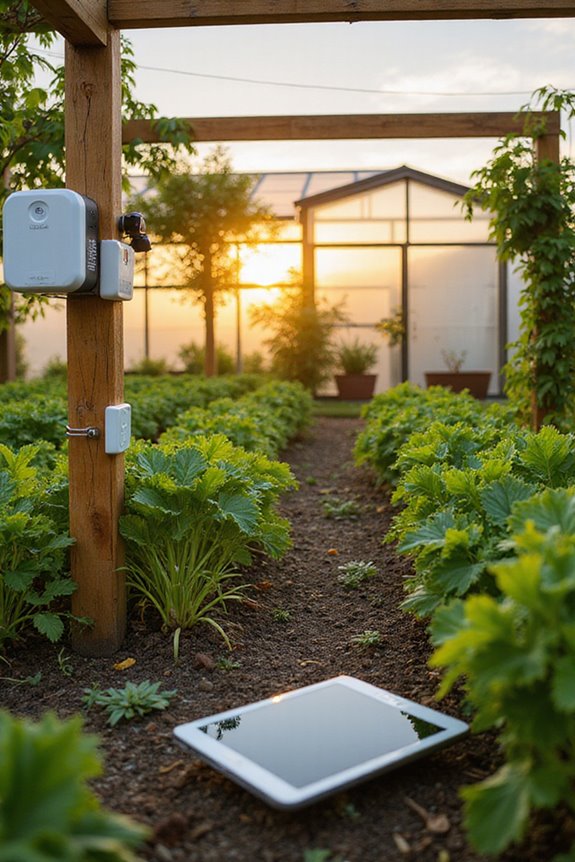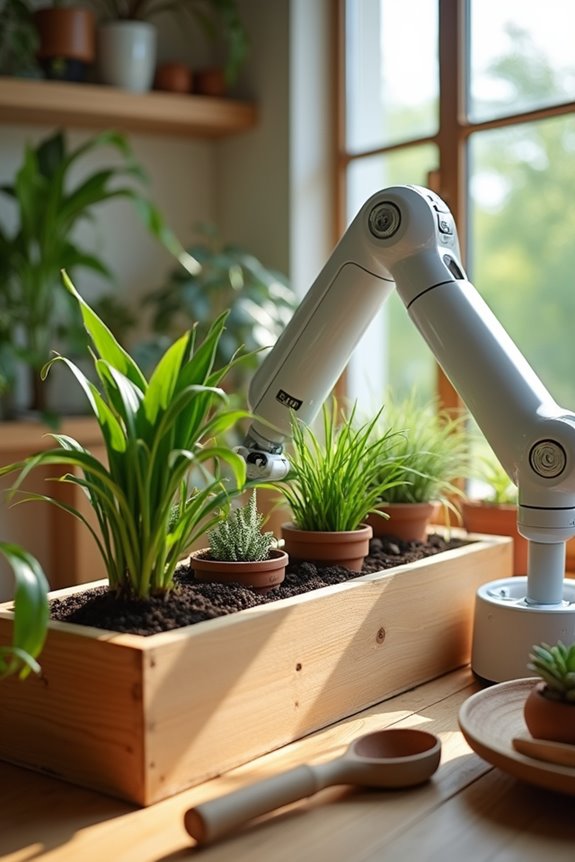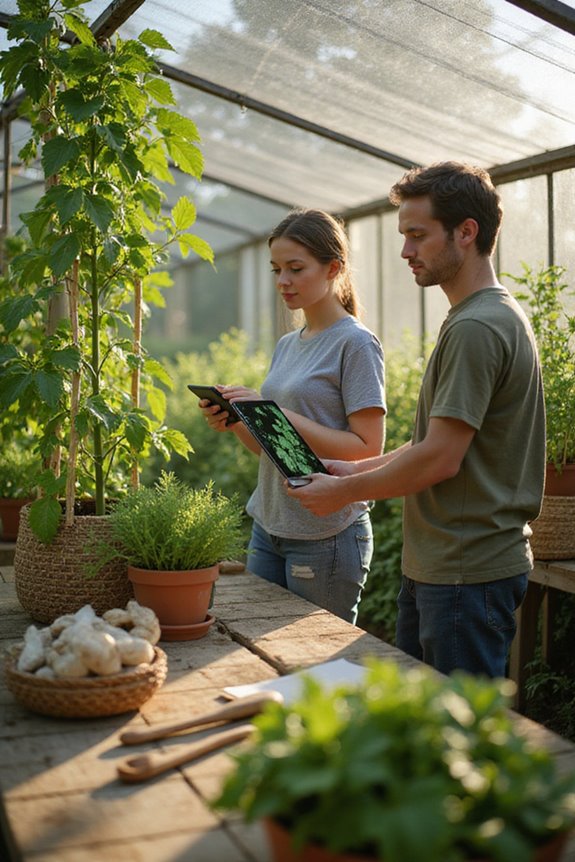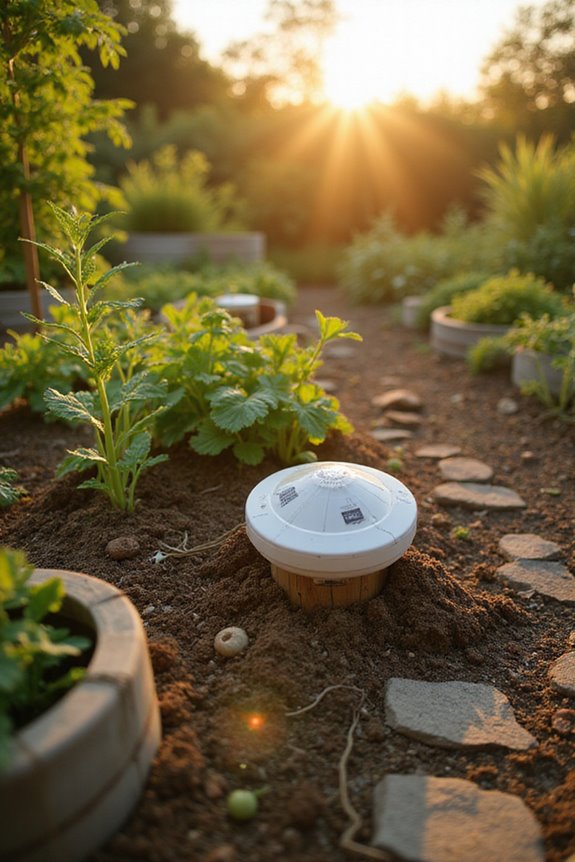To create intelligent garden networks, we can start by integrating essential components like sensors, controllers, and actuators. First, we should choose sensors for soil moisture, temperature, and light. Then, selecting a compatible controller allows for smart home connectivity and efficient irrigation management. Finally, actuators automate tasks like watering to conserve resources. By focusing on these elements, we can enhance plant care and sustainability. Continue with us to discover more about effective applications and trends in this area.
Key Takeaways
- Choose appropriate sensors for soil moisture, temperature, light intensity, and nutrients to monitor garden conditions effectively.
- Implement a robust architecture consisting of physical, network, middleware, and analytics layers for seamless integration.
- Select a compatible smart controller that supports multiple zones and integrates with home automation systems for efficient irrigation management.
- Automate irrigation and ventilation with durable actuators, utilizing weather-responsive technology to conserve water resources.
- Foster community engagement through online platforms, workshops, and local initiatives to share knowledge and promote sustainable gardening practices.
Understanding the Basics of Intelligent Garden Networks
Intelligent garden networks combine technology and nature to optimize plant care. To understand these systems, we can look at their network architecture, which has several layers.
- Physical Layer: This includes hardware like microcontrollers and sensors that gather data about our plants.
- Network Layer: Here, communication technologies like Wi-Fi and LoRa transmit this data to our devices for analysis.
- Middleware: This acts as a bridge, managing our IoT devices and integrating them with cloud services.
- Analytics Layer: This is where big data helps us make informed decisions about our gardens.
Selecting the Right Sensors for Your Garden
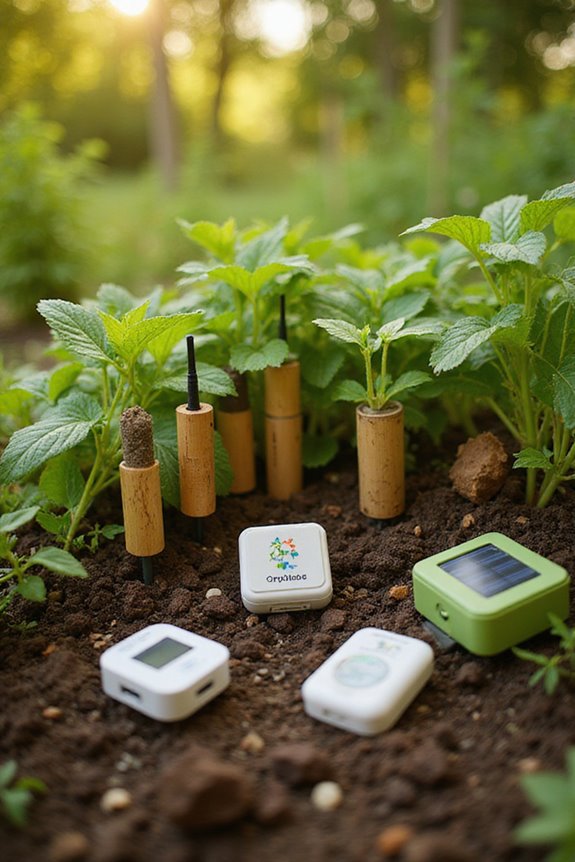
When selecting sensors for our gardens, it’s essential to take into account several factors to guarantee we get the best performance. First, we should consider various sensor types, such as soil moisture, temperature, light intensity, and nutrient sensors. Each type plays a unique role in monitoring our plants’ needs.
Next, sensor placement is critical. We need to install sensors at appropriate depths and locations, away from artificial light or heat sources that might skew data. Using multiple sensors across our garden can help us capture microclimates and varying soil conditions.
Finally, we must ascertain sensors are durable and connected, allowing for easy integration with our smart garden networks. By making informed choices, we can enhance our gardening experience.
Choosing an Effective Controller
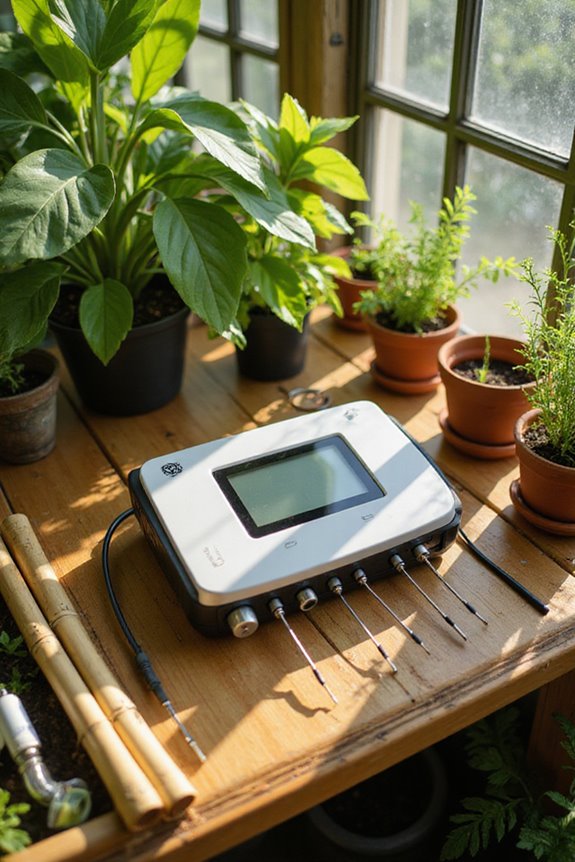
Choosing the right controller for our garden network is just as important as selecting the right sensors. Here are some key controller features to take into account:
- Compatibility: Confirm it works with smart home systems like Amazon Alexa or Google Assistant for easy voice control.
- Zone Support: Look for controllers that handle 4 to 16 sprinkler zones, allowing us to scale based on our garden size.
- Weather Responsiveness: Advanced models adjust watering based on local forecasts, helping us conserve water.
For installation tips, choose models with user-friendly instructions and weatherproof enclosures. Also, take note of power options—like plug-in AC cords or battery backup—so we’re prepared for outages. With these considerations, we’ll have a smart, efficient garden network.
Integrating Actuators for Automation
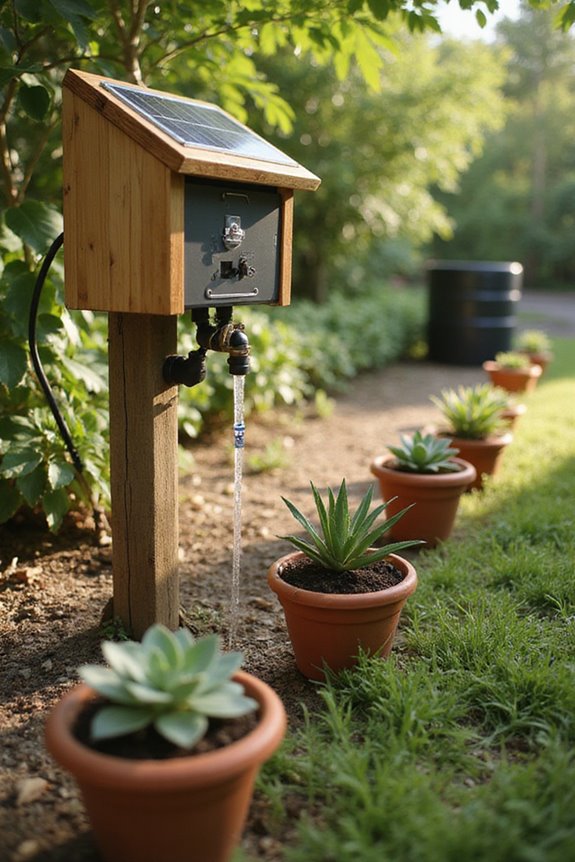
Integrating actuators into our garden automation system can greatly enhance efficiency and control. By using various actuator types, we can automate tasks like irrigation and ventilation. For example, solenoid valves manage water flow, while linear actuators open vents precisely.
To guarantee effective operation, we need to take into account actuator durability. Weather-resistant materials help them withstand outdoor conditions, assuring long-term performance. Additionally, incorporating smart sprinkler controllers can further maximize water conservation and ensure optimal plant hydration.
Here’s a quick summary of actuator benefits:
- Regulate irrigation schedules automatically.
- Optimize shading systems based on sunlight.
- Control air vents for better air circulation.
Establishing Connectivity for Remote Monitoring
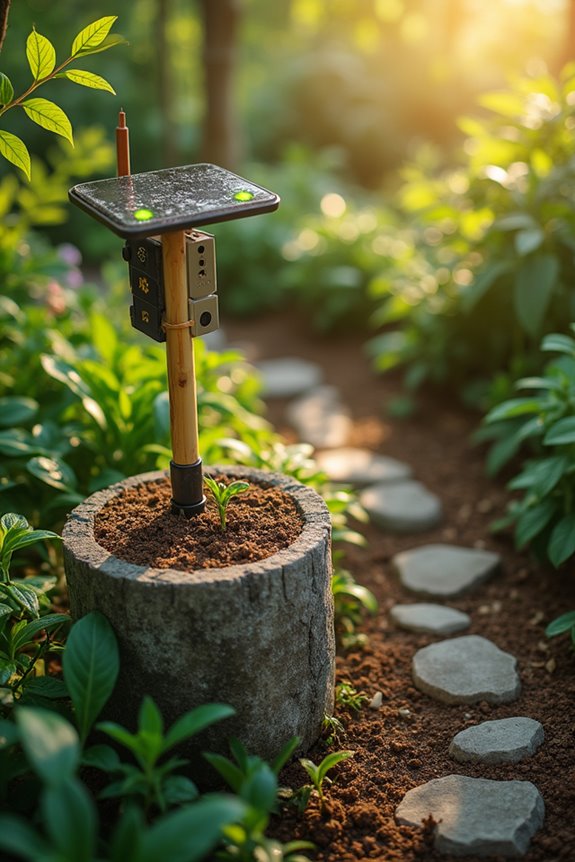
Establishing connectivity for remote monitoring is essential for optimizing our garden networks. We can use cellular connectivity and WiFi integration to guarantee real-time data transmission. LPWAN technology, like LoRaWAN, is perfect for outdoor monitoring with low-energy devices.
By integrating sensors through dedicated IoT platforms, we achieve efficient data management. Utilizing REST APIs allows our systems to respond automatically to sensor data, such as adjusting irrigation based on soil moisture levels.
Cloud systems provide remote access to our sensor networks, offering live data anytime. This means we can monitor our gardens from anywhere, making it easier to maintain plant health. With these technologies, we can enjoy a more connected and sustainable gardening experience.
Designing User Interfaces for Easy Management
Designing user interfaces for smart garden management allows us to effectively monitor and control our garden environments. A well-structured layout enhances user experience by minimizing cognitive load. For instance, large screens and clear visual design help us quickly access sensor data such as moisture and temperature levels.
- Multi-Device Access: We can manage gardens from mobile or desktop devices, ensuring flexibility.
- Real-Time Notifications: Mobile apps alert us to critical conditions, keeping us informed.
- Customization Features: We can set personalized watering schedules and even purchase supplies directly through the app.
Implementing Data-Driven Automation
Implementing data-driven automation in our gardens can greatly enhance plant health and resource management. By employing soil moisture sensors, we gain real-time insights into water levels, allowing precise irrigation control. Additionally, using temperature and humidity sensors helps us understand environmental conditions affecting our plants.
- Automated Irrigation Systems
- Smart watering systems use sensor data to adjust watering schedules.
- Drip irrigation optimizes water use and targets roots directly.
- AI algorithms analyze data to predict plant care needs.
- Machine learning helps us recognize health patterns and adjust controls.
Through these automation strategies, we can foster healthier plants and use resources more efficiently.
Ensuring Sustainable Resource Management
Guaranteeing sustainable resource management in our gardens is vital for fostering healthy ecosystems and conserving essential resources. By implementing sustainable irrigation practices, we can minimize water waste. Smart sensors help us monitor soil moisture and predict irrigation needs, reducing water consumption by up to 50%. Additionally, incorporating drought-tolerant plants can further enhance water efficiency and promote resilient landscapes.
- Optimize Water Use
- Use weather forecasts for proactive irrigation adjustments.
- Prevent overwatering with continuous moisture monitoring.
- Adjust nutrient dispensing based on plant growth stages.
- Test soil conditions to support sustainable amendments.
- Incorporate plants adapted to local conditions.
- Use smart databases to select the right species.
Together, we can guarantee resource conservation and create thriving garden networks.
Exploring Different Applications and System Types
Intelligent garden networks offer a variety of applications and system types that can revolutionize how we manage our gardens. For instance, smart irrigation systems adjust watering schedules based on soil moisture data, promoting efficient water use. Robotic maintenance tools, like lawn mowers, autonomously keep grass at the desired height, freeing us from manual labor.
Additionally, ambient lighting systems enhance our outdoor spaces, creating the perfect atmosphere while optimizing plant growth. Sensor integration allows for thorough monitoring, ensuring plants receive the right conditions. Modular systems provide flexibility, letting us customize our setups to fit our gardens. With data analytics, we can make informed decisions for environmental adaptation, all while enjoying user convenience through integrated smartphone controls.
Addressing Future Trends and Challenges
As we explore the potential of intelligent garden networks, we must also consider the future trends and challenges that lie ahead.
- Future Innovations
- Advanced AI will enhance plant care through personalized diagnostics.
- Subscription models will keep users engaged with regular seed and nutrient deliveries.
- High upfront costs may deter urban adoption despite growing interest.
- Limited space in cities requires innovative, compact gardening solutions.
- Eco-friendly materials and no-dig techniques will support sustainable practices.
- Intelligent irrigation systems will prioritize water conservation, reducing waste, while practices like efficient water use will further optimize resource management.
Frequently Asked Questions
What Is the Ideal Location for Setting up My Intelligent Garden Network?
When choosing our ideal garden layout, we should consider sunlight exposure carefully. Let’s find a spot with indirect light and good airflow, ensuring our plants thrive while creating a welcoming space for all of us.
How Much Does It Cost to Create an Intelligent Garden Network?
When we’re considering costs for creating an intelligent garden network, budget considerations and cost analysis reveal initial investments can range considerably. Together, we can explore options that fit our financial plans and gardening aspirations.
Can I Integrate My Existing Garden Equipment Into a Smart System?
Absolutely, we can integrate our existing garden equipment into a smart system. By using smart sensors and ensuring automation compatibility, we can enhance our gardening experience while keeping our beloved equipment functional and efficient.
What Types of Plants Are Best Suited for Intelligent Garden Networks?
When considering plants for intelligent garden networks, we should explore native plants and companion planting. Their natural resilience and synergy enhance our gardens, creating a thriving community that connects us with nature and each other.
How Do I Troubleshoot Common Issues in Intelligent Garden Networks?
When we troubleshoot connectivity issues in our intelligent garden networks, we should guarantee sensor calibration is accurate and check for interference. Let’s work together to enhance our garden experience and keep our devices connected!


